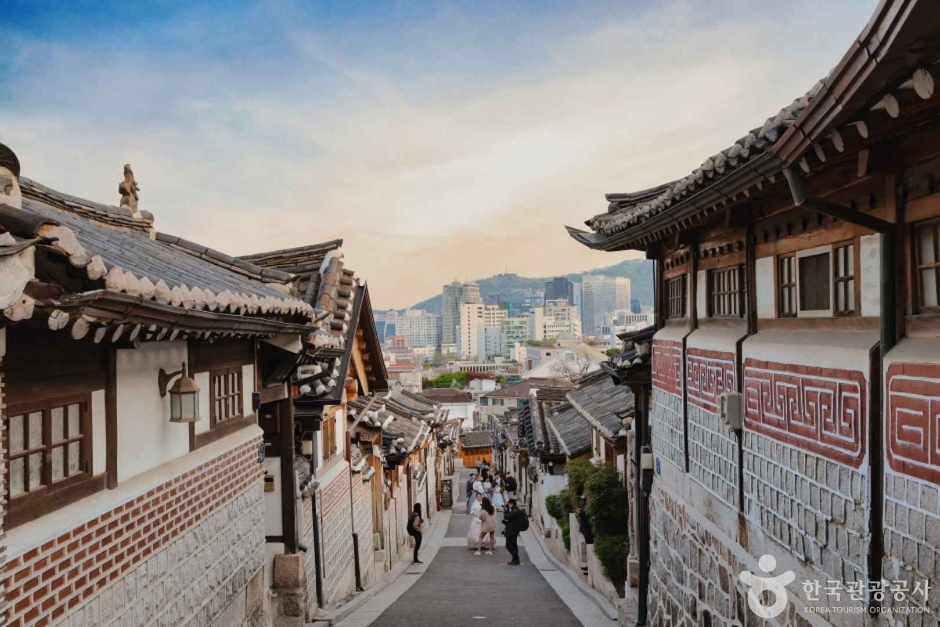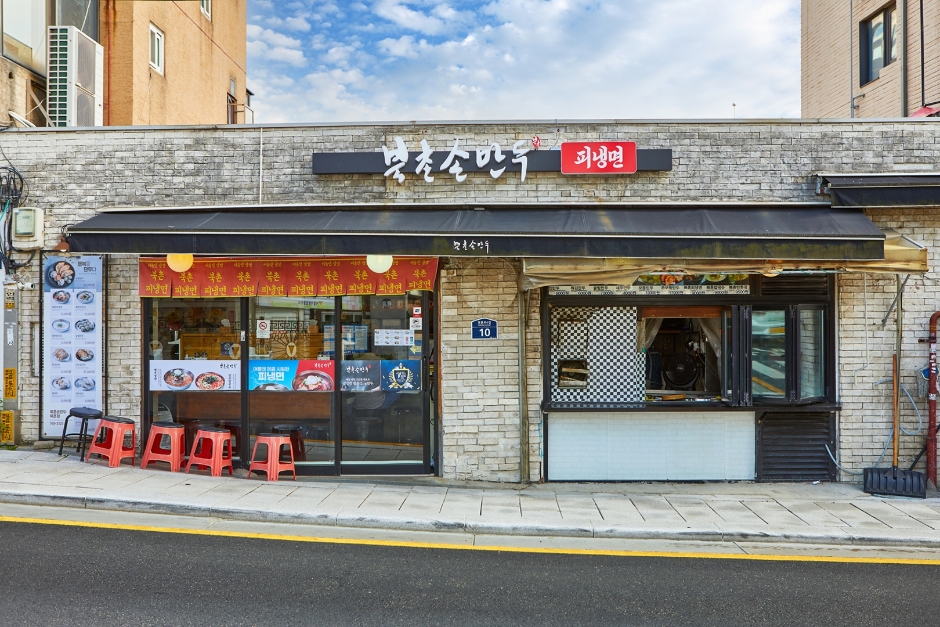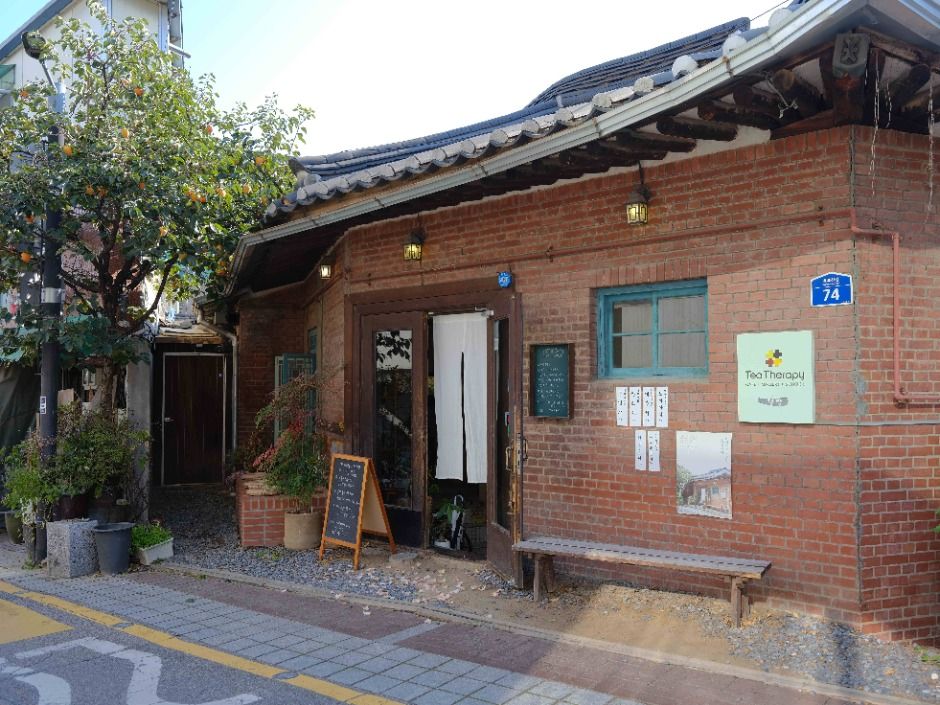Bukchon Hanok Village (북촌한옥마을)
1.6Km 2025-06-19
37 Gyedong-gil, Jongno-gu, Seoul
Surrounded by Gyeongbokgung Palace, Changdeokgung Palace and Jongmyo Shrine, Bukchon Hanok Village is home to hundreds of traditional houses, called hanok, that date back to the Joseon dynasty. The name Bukchon, which literally translates to "northern village," came about as the neighborhood lies north of two significant Seoul landmarks, Cheonggyecheon Stream and Jongno. Today, many of these hanoks operate as cultural centers, guesthouses, restaurants and tea houses, providing visitors with an opportunity to experience, learn and immerse themselves in traditional Korean culture. As Bukchon Hanok Village is an actual neighborhood with people's homes, visitors are advised to be respectful at all times while looking around.
Bukchon Son Mandu Bukchon Branch (북촌손만두 북촌점)
1.6Km 2024-12-10
This third-generation family-owned handmade mandu restaurant has been in business since 1953. Its handmade mandu bears the tradition of nearly 70 years. This restaurant distinguishes itself above others with its unique expertise in the art of mandu-making and fresh ingredients, capturing deep flavors with care in each mandu. A full spread of mandu is available here, from steamed mandu to thin-skin mandu, deep-fried mandu, shrimp mandu, and galbi mandu, which can be ordered in individual pieces or as an assorted package. Mandu and noodles go perfectly together, and here, visitors can enjoy mandu with cold buckwheat noodles or noodle soup. The most recommended menu is the noodle soup, which serves thick, plump noodles in warm broth. But that does not mean that the cold buckwheat noodles are lacking: cold buckwheat noodles are served in a cool, red kimchi broth.
Tea Therapy (티테라피)
1.6Km 2025-10-23
74 Yunboseon-gil, Jongno-gu, Seoul
+82-2-730-7507
Located in Jongno-gu, Seoul, Tea Therapy can be of help to those who chronically feel unwell even though they do not have any serious diseases that need to be treated. It is a place where medicinal herbal teas, which once seemed difficult to enjoy, can be enjoyed without hassle and in a unique way. The teas found at Tea Therapy can be brewed within three minutes, similar to herbal teas found in other countries, and are both delicious and good for your health. Tea Therapy recommends tea through testing so even novices can have fun selecting teas that suit them. Tea products are sold here as well, allowing you to enjoy the same flavors at home.
London Bagel Museum Anguk Main Store (런던베이글뮤지엄 안국점)
1.6Km 2024-02-20
20 Bukchon-ro 4-gil, Jongno-gu, Seoul
London Bagel Museum is a bagel specialty shop adorned with a wooden-tone interior and a garland in the shape of the British flag. The bagels are made using the traditional British method of fermenting the dough, boiling it, and then baking it in the oven. Jambon butter sandwich bagel, made with sesame bagel filled with ham and butter, is a signature menu item.
The Handsome Obzee - Lotte Seoul Station Branch [Tax Refund Shop] (한섬 오브제 롯데서울역)
1.6Km 2024-04-23
405, Hangang-daero, Yongsan-gu, Seoul
-
Lotte Mart - Seoul Station Branch [Tax Refund Shop] (롯데마트 서울역점)
1.6Km 2024-04-22
426, Cheongpa-ro, Jung-gu, Seoul
-
Daehyun Dewl - Lotte Seoul Station Branch [Tax Refund Shop] (대현 듀엘 롯데서울역)
1.6Km 2024-04-17
405, Hangang-daero, Yongsan-gu, Seoul
-
Lloyd - Lotte Seoul Station Branch [Tax Refund Shop] (로이드 롯데서울역)
1.6Km 2024-04-18
2F Lotte Outlet Seoul Station Branch, 405, Hangang-daero, Yongsan-gu, Seoul
-
Lotte Outlets - Seoul Station Branch [Tax Refund Shop] (롯데아울렛 서울역점)
1.6Km 2024-07-30
405, Hangang-daero, Yongsan-gu, Seoul
- Located in the heart of transportation at Seoul Station, LOTTE Seoul Station offers convenience with easy access to nearby public transport and parking and holds a diverse selection of brands under the YOUNG & SPORTY concept. Experience top-notch services tailored to our foreign guests in our Global Service Room.
Converse - Lotte Outlets Seoul Station Branch [Tax Refund Shop] (컨버스 롯데아울렛 서울역점)
1.6Km 2024-06-27
405, Hangang-daero, Yongsan-gu, Seoul
-




![The Handsome Obzee - Lotte Seoul Station Branch [Tax Refund Shop] (한섬 오브제 롯데서울역)](http://tong.visitkorea.or.kr/cms/resource/19/2878419_image2_1.jpg)
![Lotte Mart - Seoul Station Branch [Tax Refund Shop] (롯데마트 서울역점)](http://tong.visitkorea.or.kr/cms/resource/40/2887940_image2_1.jpg)
![Daehyun Dewl - Lotte Seoul Station Branch [Tax Refund Shop] (대현 듀엘 롯데서울역)](http://tong.visitkorea.or.kr/cms/resource/96/2878396_image2_1.jpg)
![Lloyd - Lotte Seoul Station Branch [Tax Refund Shop] (로이드 롯데서울역)](http://tong.visitkorea.or.kr/cms/resource/17/2878417_image2_1.jpg)
![Lotte Outlets - Seoul Station Branch [Tax Refund Shop] (롯데아울렛 서울역점)](http://tong.visitkorea.or.kr/cms/resource/80/3003480_image2_1.jpg)
![Converse - Lotte Outlets Seoul Station Branch [Tax Refund Shop] (컨버스 롯데아울렛 서울역점)](http://tong.visitkorea.or.kr/cms/resource/77/3313777_image2_1.jpg)
 English
English
 한국어
한국어 日本語
日本語 中文(简体)
中文(简体) Deutsch
Deutsch Français
Français Español
Español Русский
Русский